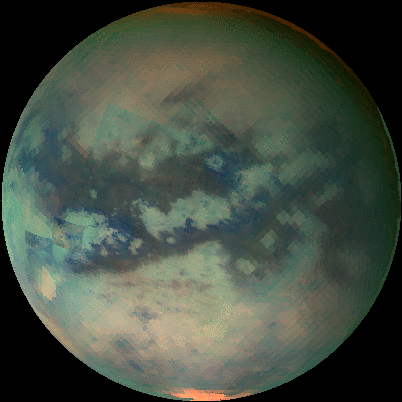English: This movie of Titan shows data taken with Cassini's visual and infrared mapping spectrometer during the last three flybys of Titan. The flybys took place on Oct. 28, 2005, Dec. 26, 2005, and Jan. 15, 2006.
These false-color images were taken at wavelengths of 1.6 microns shown in blue, 2.01 microns in green and 5 microns in red.
The viewing geometry of the December flyby is roughly on the opposite hemispheres of the flybys in October and January. There are several important features shown by the movie. First, the globe of Titan exhibits two major types of terrain. One is very bright, and a darker one seems to be concentrated near the equator. Titan also has two very bright regions, the large one known as Tui Reggio, and the other as Hotei Arcus. These regions are thought to be surface deposits, probably of volcanic origin, and may be water and/or carbon dioxide frozen from the vapor. The December flyby data show that the western margins of Tui Reggio have a complex flow-like structure consistent with eruptive phenomena. The reddish feature at the south pole is Titan's south polar cloud system, which was very bright during the December flyby. During the October and January flybys it is barely visible, indicating that the atmosphere over titan's south pole is very dynamic.
The Cassini-Huygens mission is a cooperative project of NASA, the European Space Agency and the Italian Space Agency. The Jet Propulsion Laboratory, a division of the California Institute of Technology in Pasadena, manages the mission for NASA's Science Mission Directorate, Washington, D.C. The Cassini orbiter was designed, developed and assembled at JPL. The visual and infrared mapping spectrometer team is based at the University of Arizona.
For more information about the Cassini-Huygens mission
http://saturn.jpl.nasa.gov/home/index.cfm The visual and infrared mapping spectrometer team homepage is at
http://wwwvims.lpl.arizona.edu.




